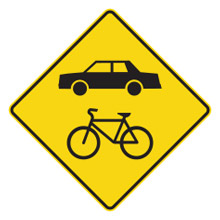Are cyclists required to use bike lanes?

People tend to think that where a bike path or lane exists, cyclists are required to use it. But is that really true?
Four types of roadway reserved for cyclists
First of all, what exactly is a bike “path” or “lane?” There are four types on our roads:
- Paved shoulders (on highways, but not autoroutes);
- Bicycle lanes, reserved for the exclusive use of cyclists;
- Bicycle paths, physically separated from roads; and
- Designated lanes, which are shared by both cyclists and motorists; these are marked by a bicycle pictogram on the pavement, or a diamond-shaped yellow road sign showing a car and bicycle sharing the road.

Source: Répertoire des dispositifs de signalisation routière du Québec
But are these roadways mandatory for cyclists?
If you’re a cyclist, the Highway Safety Code says you can use any public road, regardless of whether there is a parallel bike lane. The latter are sections of roadway almost exclusively reserved for cyclists, of course, so their usefulness is obvious: they make cycling safer. Therefore, you shouldn’t hesitate to look for them and use them, and enjoy your ride in peace! And remember, sidewalks are not included in the definition of “public road.” On the contrary: riding a bike on the sidewalk is forbidden.
What about children?
In Quebec, cyclists aged 12 and older as well as children accompanied by a legal adult are allowed to ride on any road other than major highways (autoroutes) and their on- or off-ramps. Children aged under 12 may not ride on roads where the speed limit exceeds 50 km/h unless they are in a bike lane or accompanied by an adult.
And groups?
If you’re going on a group ride, be aware that Section 486 of the Highway Safety Code states that cyclists in groups of two or more must ride single file, and the group must not comprise more than 15 cyclists.
Listen up!
Headphones, earbuds and earpieces are forbidden while cycling, regardless of whether you’re in a dedicated lane or on the road. Cycling’s growing popularity in urban areas means bike paths and lanes are increasingly crowded, and that in turn means riders must be more alert. Your hearing is a very important faculty, especially given that riding a bike is a fairly quiet mode of transportation: being able to hear the noise of surrounding traffic can mean the difference between getting into an accident with a car or another cyclist and avoiding one.


Benefit from personalized advice
Do you have questions about gas-powered or electric vehicles, driving, or need recommendations to find an Approved Auto Repair Service?